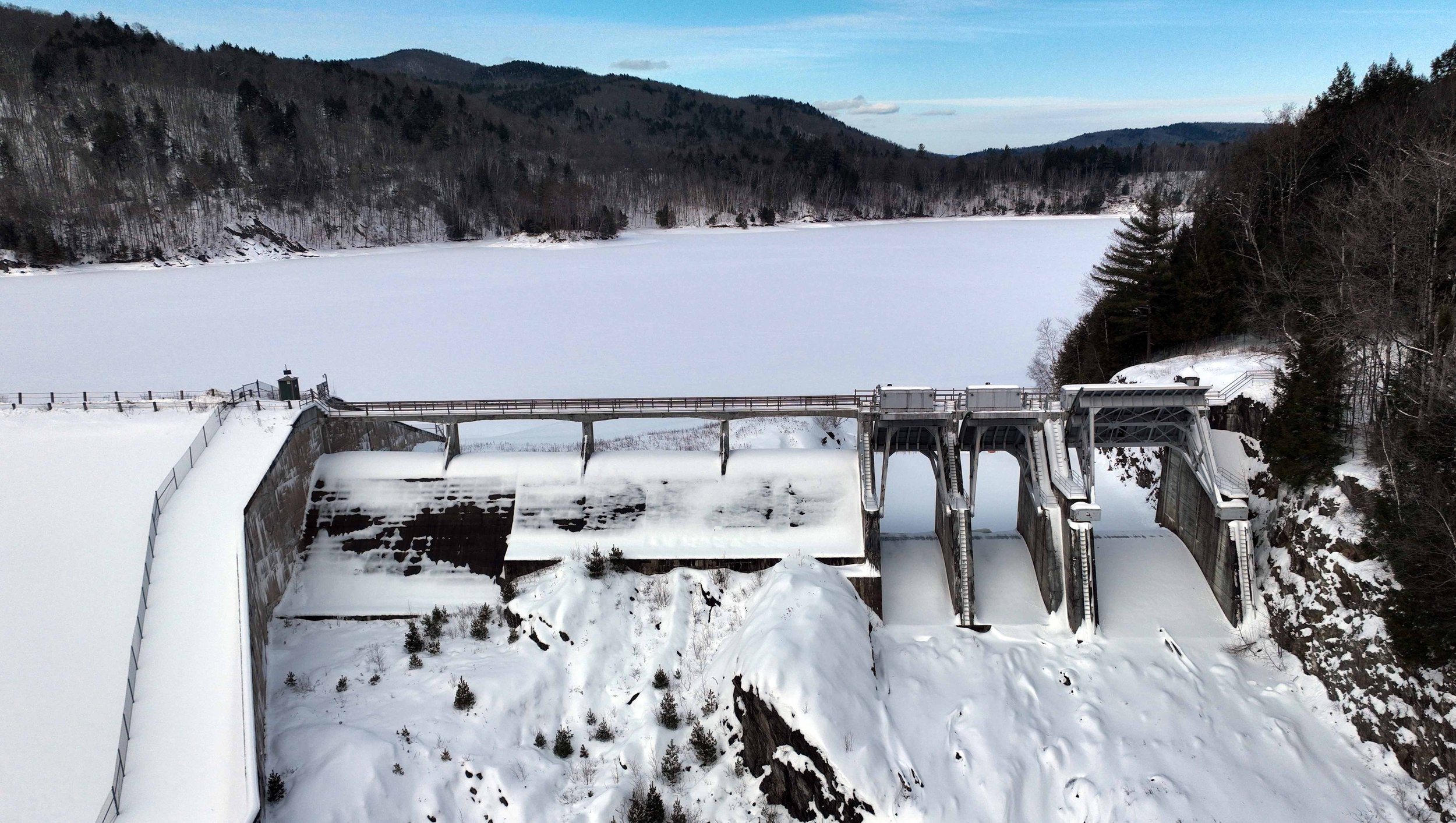Officials prepare for Waterbury Dam facelift starting in 2027
February 15, 2025| By Camila Van Order González | Community News Service
The dam on the Waterbury Reservoir is nearly a century old. Photo by Gordon Miller
When work began on building the Waterbury Dam, Vermonters were just a few years removed from the deadliest natural disaster in state history, the Great Flood of 1927.
Nearly 100 years later, officials say the dam needs repairs if it’s to withstand more of the catastrophic floods that have recently hit the area.
Starting in 2027, a century after the Great Flood, builders will replace the floodgates with thicker, sturdier ones and swap out the bridge above the spillway for a new structure.
The project will mean substantially lowering the reservoir water level, affecting all activity on the popular water body and use of the two state parks surrounding it for about two years.
The planned construction is part of the Waterbury Dam Spillway Project, a state-federal collaboration originally conceived seven years ago and pegged at about $90 million. In addition to providing needed maintenance on the dam, it’s also meant to reduce the flooding that has haunted downstream communities in recent years due to erosion and overflow at the dam.
“These flood control dams are being asked to do more and store more water, particularly in the last few years,” said Ben Green, chief dam safety engineer with the Department of Environmental Conservation. “So getting this project done in the near future is pretty important.”
The structure is a crucial shield for folks downstream. “It protects communities from Middlesex all the way to Richmond from possible flooding effects from the Little River Valley in Stowe,” said Neil Kamman, the department’s deputy commissioner.
The three gates atop the dam control the water level. Photo by Gordon Miller
The dam’s spillway was originally constructed in the 1930s and consists of three gates above a rocky downslope beside the dam. Workers can safely send water from the Waterbury Reservoir out through the gates and down the channel. In the decades since, the dam’s concrete has shifted and weakened and its metal is fatigued.
“The reservoir can only safely hold about two-thirds of its designed flood capacity,” Green said.
The project follows years of collaboration between the Department of Environmental Conservation and the U.S. Army Corps of Engineers. In late January, the latter released a report outlining all the impacts the project will likely have, environmentally and culturally.
The plan’s environmental disruptions won’t be significant enough to require a lengthier, stricter review process required by law, the Corps concluded. Its public notice explains that the public has until Feb. 25 to send in comments online or by mail.
Impact to Waterbury’s state parks
The proposal wouldn’t come without noticeable changes to the physical landscape of natural areas such as Little River State Park during the two-year construction period. The project would require the reservoir to be lowered by 30-60 feet, redirecting water away and leaving swaths of the reservoir bed out in the open, according to the report.
“The edge of the water will be receded substantially back down into the reservoir,” Kamman said.
The water has gone down before, such as during minor repairs to the spillway in the mid-2000s. The proposed drawdown would go for 18 months.
“There’s no way you could launch a boat during that time,” said Eric Chittenden, board president of the nonprofit organization Friends of Waterbury Reservoir.
Vermont State Parks northeast region manager Nick Caputo said the Waterbury Center State Park might have to close for a few seasons due to the water drawdown.
Sheila Goss’ dog, Kanootti enjoys a paddle on the Waterbury Reservoir last summer. Photo by Sheila Goss
But every cloud has a silver lining: “We’re going to use this opportunity to start a public process to get public input for any operational or design changes to Waterbury Center,” Caputo said. “If there’s no swimming available, we want to see what we can do to bring the park up to a more modern standard.”
Losing the reservoir would fall hard on Waterbury canoeing enthusiasts such as Sheila Goss, vice president of the Friends of Waterbury Reservoir group’s board. Goss said she canoed 273 out of 365 days last year with her dog, Kanootti (a Finnish word for “canoe”). “If the reservoir reaches the same status it had 20 or so years ago … I will lose that easy access,” she said.
Goss, however, is much more concerned about the environmental impact. The Friends of Waterbury Reservoir have done extensive work taking care of loons on the reservoir in the past five years.
“I really don’t know, depending on what the water ends up at, what’s going to happen to our loons,” Goss said. “A lot of the loons … that are working their way over to the coast –– where they go for the winter –– a lot of them use the Waterbury Reservoir as a stop-off spot to rest and recover and get ready to fly the rest of the way.”
Loons on the Waterbury Reservoir. File photo by Gordon Miller
While the draining would be unsightly and unfortunate, “there’s really no other way to do it,” said Green, the dam safety engineer with the state. “If we had a major flood during the project, we can’t rely on a half-built spillway, so we need to be able to keep the water down.”
While the project is scheduled to begin in 2027 and take three years to complete, just over half of the needed $90 million for the work has been committed to date.
VTDigger has reported that the U.S. The Army Corps of Engineers has approximately $50 million for the work through an appropriation Vermont’s congressional delegation secured through the federal Water Resources Development Act. The funding is appropriated to the corps, not as a project grant, and it would mean the state would provide 7.5% of the total cost with the federal government covering 92.5%.
Asked by VTDigger about the need for the remaining $40 million as federal spending has come under new scrutiny in recent weeks with the new administration in Washington D.C., Kamman acknowledged the challenge.
“It is obviously a very uncertain environment with respect to federal appropriations right now,” Kamman said. “But water infrastructure is pretty important stuff, and we will see how things progress in the coming congressional sessions.”
The Waterbury dam and reservoir on Feb. 13, 2025. Photo by Gordon Miller
Community News Service is a University of Vermont journalism internship program reporting for Vermont news organizations including Waterbury Roundabout.





